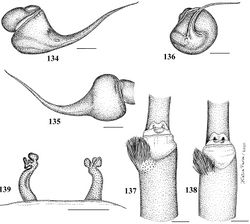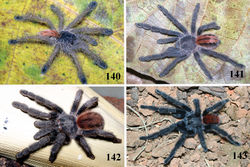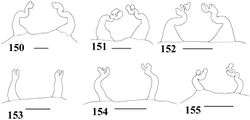Iridopelma katiae
| Notice: | This page is derived from the original publication listed below, whose author(s) should always be credited. Further contributors may edit and improve the content of this page and, consequently, need to be credited as well (see page history). Any assessment of factual correctness requires a careful review of the original article as well as of subsequent contributions.
If you are uncertain whether your planned contribution is correct or not, we suggest that you use the associated discussion page instead of editing the page directly. This page should be cited as follows (rationale):
Citation formats to copy and paste
BibTeX: @article{Bertani2012ZooKeys230, RIS/ Endnote: TY - JOUR Wikipedia/ Citizendium: <ref name="Bertani2012ZooKeys230">{{Citation See also the citation download page at the journal. |
Ordo: Araneae
Familia: Theraphosidae
Genus: Iridopelma
Name
Iridopelma katiae Bertani, 2012 sp. n. – Wikispecies link – ZooBank link – Pensoft Profile
Diagnosis
Male resemble those of Iridopelma zorodes and Iridopelma vanini sp. n. in similar leg I and IV lengths (leg IV/I length =1.04, SD= 0.02). It differs from Iridopelma zorodes by blackish coloration with a reddish pattern on abdomen dorsum (Fig. 143). It differs from Iridopelma vanini sp. n. by shorter embolus (Figs 134–136). Female differs from those of all species in spermathecal morphology, two straight to slightly curving spermathecae tapering little from base to apex, lacking folds and with constriction forming two to multiple distal lobes (Fig. 139). Additionally, females have a general blackish coloration with a reddish pattern on abdomen dorsum (Fig. 142).
Etymology
The specific name is a matronym in honour of my wife, Kátia de Mendonça Faria, who illustrated several plates for spider taxonomy papers, this work included.
Types
Holotype female, Brazil, Bahia, Mucugê, Parque Nacional da Chapada Diamantina (12°45'7.00"S, 41°30'2.18"W), 1399 m a.s.l., R. Bertani, C. S. Fukushima and R. H. Nagahama, 18 February 2008 (MZSP 36887); Paratype male (12°45'3.77"S, 41°30'4.01"W), 1377 m a.s.l., 17 February 2008 (MZSP 36888), same data; Paratype male (12°45'4.18"S, 41°30'3.73"W), 1366 m.a.s.l, same data (MZSP 36889); Paraype female (12°45' 2.50"S, 41°30'4.15"W), 1388 m.a.s.l, same data, found with ca. 100 young (MZSP 36890). All specimens found inside bromeliads (Vriesea atra) in a campo rupestre area.
Additional material examined
BRAZIL: Bahia: Ibicoara, Serra do Sincorá [13°24'S, 41°15'W], G. Machado, 12 March 2000, 2 females (MZSP 22762); Rio de Contas [13°35'S, 41°48'W], O. A. V. Marques and G. Skuk, 09 October 1991, 1 female, 1 immature (IBSP 10317).
Description
Holotype female (MZSP 36887). Carapace 13.3 long, 12.7 wide, chelicerae 7.7. Legs (femur, patella, tibia, metatarsus, tarsus, total): I: 11.3, 6.5, 8.2, 7.6, 4.6, 38.2. II: 10.0, 6.1, 7.2, 7.0, 4.3, 34.6. III: 9.3, 5.3, 6.4, 6.9, 4.1, 32.0. IV: 10.9, 5.2, 8.8, 9.6, 4.7, 39.2. Palp: 7.9, 4.6, 5.3, –, 5.9, 23.7. Mid-widths (lateral): femora I–IV = 2.4, 2.5, 2.8, 2.4, palp = 2.2; patellae I–IV = 2.7, 2.6, 2.5, 2.5, palp = 2.3; tibiae I–IV = 2.1, 2.1, 2.1, 2.0, palp = 2.1; metatarsi I–IV = 1.9, 1.7, 1.6, 1.6; tarsi I–IV = 2.1, 2.1, 2.1, 2.0, palp = 2.1. Abdomen 18.4 long, 13.0 wide. Spinnerets: PMS, 1.7 long, 0.7 wide, 0.3 apart; PLS, 2.1 basal, 1.4 middle, 1.5 distal; mid-widths (lateral), 1.3, 1.1, 0.8, respectively. Carapace: length to width 1.04. Fovea: shallow, 2.3 wide. Eyes: tubercle 0.5 high, 1.8 long, 2.4 wide. Clypeus 0.6. Anterior eye row procurved, posterior slightly recurved. Eye sizes and inter-distances: AME 0.4, ALE 0.6, PME 0.5, PLE 0.6, AME–AME 0.6, AME–ALE 0.4, AME–PME 0.2, ALE–ALE 1.5, ALE–PME 0.3, PME–PME 1.4, PME–PLE 0.08, PLE–PLE 1.8, ALE–PLE 0.3, AME–PLE 0.5. Ratio of eye group width to length 2.0. Maxillae: length to width: 1.9. Cuspules: 100–120 spread over ventral inner heel. Maxillary lyra absent. Labium: 1.6 long, 2.0 wide, with ca. 100 cuspules spaced by one diameter from each other on the anterior third. Labio-sternal groove deep, narrow, sigilla not evident. Chelicerae: basal segments with ten teeth decreasing in size from distal to basal portion. Sternum: 6.2 long, 5.3 wide. Legs: leg formula: I=IV II III. Scopula: Tarsi I–III fully scopulate, IV basal half divided by row of 6–7 setae. Metatarsi I–II 4/5 scopulate; III 2/3, IV 1/3 distal scopulate. IV divided by three wide row of setae. Urticating hairs type II (0.45 to 0.51 long, 0.012 wide) on abdomen dorsum. Genitalia: paired slightly curving inwards spermathecae tapering slightly from base to apex, not folded, with constriction forming two to multiple distal lobes (Fig. 139). Color pattern: carapace, chelicerae, legs and palps black, covered with hairs having a weak golden iridescence. Coxae, labium, sternum, and maxillae black. Longitudinal stripes on dorsum of femora, patellae, tibiae and metatarsi inconspicuous. Distal femora, patellae, tibiae and metatarsi with discrete whitish rings. Abdomen dorsum black with longitudinal large band of long reddish setae on the central area, forming a pattern. Sparse long red setae over lateral area of abdomen. Abdomen ventrally black (Fig. 142).
Description
Paratype male (MZSP 36888). Carapace 12.1 long, 11.2 wide, chelicerae 6.5. Legs (femur, patella, tibia, metatarsus, tarsus, total): I: 11.7, 6.6, 9.1, 10.5, 5.2, 43.1. II: 10.8, 6.0, 8.3, 9.3, 4.8, 39.2. III: 9.5, 4.6, 7.0, 8.2, 4.6, 33.9. IV: 11.4, 5.5, 9.7, 11.0, 4.5, 42.1. Palp: 6.6, 4.4, 4.9, –, 2.6, 18.5. Mid-widths (lateral): femora I–IV = 2.1, 2.0, 2.4, 2.4, palp=1.7; patellae I–IV = 2.1, 2.3, 2.2, 2.2, palp = 2.0; tibiae I–IV = 1.9, 1.8, 1.6, 1.9, palp = 1.7; metatarsi I–IV = 1.3, 1.3, 1.3, 1.2; tarsi I–IV = 1.2, 1.3, 1.5, 1.2, palp = 1.8. Abdomen 12.3 long, 8.1 wide. Spinnerets: PMS, 1.4 long, 0.5 wide, 0.2 apart; PLS, 2.4 basal, 1.2 middle, 1.7 distal; mid-widths (lateral), 0.9, 0.8, 0.6, respectively. Carapace: length to width 1.08. Fovea 1.8 wide. Eyes: tubercle 0.8 high, 1.5 long, 2.1 wide. Clypeus 0.4. Anterior eye row procurved, posterior straight. Eyes size and inter-distances: AME 0.4, ALE 0.4, PME 0.3, PLE 0.4, AME–AME 0.4, AME–ALE 0.3, AME–PME 0.2, ALE–ALE 1.3, ALE–PME 0.4, PME–PME 1.1, PME–PLE 0.1, PLE–PLE 1.6, ALE–PLE 0.3, AME–PLE 0.5. Ratio of eye group width to length 2.1. Maxillae: length to width: 1.6. Cuspules: 120–150 spread over ventral inner heel. Labium: 1.3 long, 2.1 wide, with ca. 90 cuspules spaced by one diameter from each other on the anterior third center. Labio-sternal groove shallow, flat, with two sigilla. Chelicerae: basal segments with eleven teeth decreasing in size from distal to basal portion. Sternum: 5.1 long, 4.9 wide. Legs: leg formula: I=IV II III. Scopula: Tarsi I–IV fully scopulate, IV with a row of sparse setae. Metatarsi I–II 4/5 scopulate; III 1/2 distal scopulate; IV 1/3 distal scopulate. IV divided by three wide row of setae. Tibial spurs. Legs: I, single, 0.4 long, 1.2 wide (Fig. 137); II, 0.2 long, 1.1 wide (Fig. 138); both with numerous spiniform setae on their tips. Urticating hairs type II (0.72 to 0.75 long, 0.015 wide) on abdomen dorsum. Palp: embolus 3.2 long, with a 90° curvature to retrolateral side. Embolus basal, middle and distal width of 0.8, 0.2 and 0.04, respectively. Tegulum 1.0 long, 1.5 wide. (Figs 134–136). Cymbium: spiniform process 0.7 long, 0.5 wide on the apex. Color pattern and setation as in female (Fig. 143).
Distribution
Brazil: state of Bahia, endemic to Chapada Diamantina and its immediate surrounding regions, in Espinhaço mountain range (Fig. 169).
Spermathecae variation
Typical spermatheca is slender, slightly curving inwards, tapering little from base to apex, not folded, with a distal constriction forming two to multiple distal lobes (Fig. 139, 153–155). Detected variation concerns shape and number of lobes.
Natural history
Two specimens were found under rocks in Ibicoara (G. Machado, pers. comm.) and in Rio de Contas, both in state of Bahia. I found four specimens in Mucugê, Parque Nacional da Chapada Diamantina, all inside bromeliads (Vriesea atra) (Fig. 147). One of the specimens folded a bromeliad leaf and connected it with silk threads, making a retreat (Fig. 148). Inside with the mother were ca. 100 small juveniles (Fig. 149). The region where they were found is high (1400 m. a. s. l.) (Fig. 144) and vegetation is sparse, growing over a rocky substratum with shallow soil (campo rupestre) (Figs 145–146). Temperature is high during the day, falling abruptly at night. Water is largely available only during the rainy period. That’s a very distinct environmental condition when compared with the habitat in rainforest of Iridopelma hirsutum and Iridopelma zorodes, and seems inhospitable, mainly for an arboreal species. In this environment, bromeliads and space under rocks are among the few available shelter for spiders.
Cladistic analysis suggests that a retreat made with tree leaves and silk is primitive for Iridopelma species, and bromelicolous habitat in Iridopelma katiae sp. n. is derived. A possibility to explain the habit change could be the existence of a primitive forest in the area which became drier more recently in geological time, resulting in grasslands over a rocky or sandy shallow soil and lack of high vegetation. Bromeliads then become the primary (and relatively scarce) available microhabitat with similar conditions and resources, e. g. leaves as substratum and high humidity, necessities for an aviculariine spider. The environmental conditions in campo rupestre areas in Chapada Diamantina could aid in understanding the specialization to endemic bromelicolous lifestyle in other spider species, such as Pachistopelma spp.
Color pattern ontogeny
Juveniles have light brown legs, except for black tarsi. Carapace is black and abdomen has a broad central longitudinal red stripe over a black area. Abdomen laterals are light brown (Fig. 140). When the individual grows, it becomes darker and retains the abdominal pattern, now with a longitudinal central black stripe (Fig. 141). Adults males and females are completely black and have a conspicuous abdominal pattern remains (Figs 142–143).
Original Description
- Bertani, R; 2012: Revision, cladistic analysis and biogeography of Typhochlaena C. L. Koch, 1850, Pachistopelma Pocock, 1901 and Iridopelma Pocock, 1901 (Araneae, Theraphosidae, Aviculariinae) ZooKeys, 230: 1-94. doi
Images
|




